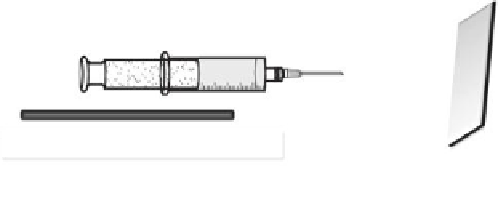Environmental Engineering Reference
In-Depth Information
23.2 Process of Electrospinning
Electrospinning is a well-known technique for making continuous submicron to nanosized
1-dimensional (1D) ibers.
9
It has the potential to fabricate 1D nanostructures of a wide
range of material systems.
10 -12
An electrospinning setup consists mainly of three compo-
nents, a high voltage source, a spinneret (a syringe or capillary tube with a needle of small
diameter and a grounded collecting plate, either a rotating mandrel or a metallic plate). A
schematic of an electrospinning setup is shown in Figure 23.2. A high potential is applied
between the needle tip and the collector. The interactions of the electrical charges in the
polymeric solution with the applied ield causes the polymer droplet near the needle tip to
deform to a conical shape known as a Taylor cone. When the applied voltage exceeds the
critical voltage at which the repulsive force overcomes the surface tension, a thin charged
jet is ejected from the Taylor cone. These charged jets undergo a helical motion and are
elongated continuously and during the process the solvent is thrown out. The elongated
jet reaches the ground collector and solidiies as ine ibers. If the applied ield is not above
the critical voltage, it will cause the jet to break up into droplets. The parameters inluenc-
ing the diameter and morphology of nanoibers include applied voltage, distance between
the spinneret and the collector, solution feeding rate, molecular weight of the polymer,
viscosity, conductivity, and surface tension of the polymeric solution. The other important
factors affecting the electrospinning process are the solution temperature, humidity, and
air velocity inside the electrospinning chamber. Electrospinning can be used to produce
both aligned and nonaligned nanoibers.
13,14
If a rotating drum or cylinder is used as the
collector, the nanoibers can be aligned in some fashion.
Electrospun nanoibers possess several attractive qualities such as high surface-to-
volume ratio, high porosity, pore sizes ranging from tens of nanometers to several microns,
interconnected open pore structure that allows easy accessibility of the pores to water, and
high permeability of gases.
1
The composition of the nanoibers can be controlled to achieve
desired surface functionalities and properties. One of the limitations associated with
laboratory-scale needle-based electrospinning is the low yield of ibers. However, this has
been addressed by developing multi-jet- and blowing-assisted electrospinning, which pro-
duce nanoibers on an industrial scale.
15,16
ELMARCO s.r.o. (Czech Republic) has commer-
cialized needleless-based electrospinning machines suitable for industrial applications.
17
Jet
Solution
Needle
Grounded
collector
Taylor cone
Dispenser pump
_
High-voltage source
FIGURE 23.2
Schematic of an electrospinning setup.


























